Advantages of the Double Ridge Waveguide Design
In today's demanding microwave applications, engineers face constant challenges with signal integrity, bandwidth limitations, and size constraints in traditional waveguide systems. When your radar systems demand broader frequency coverage, your satellite communications require enhanced performance, or your defense applications need more compact solutions, the Double Ridge Waveguide emerges as the superior choice. This innovative design addresses critical pain points that have plagued conventional waveguide technology for decades, offering exceptional bandwidth extension, reduced size requirements, and improved impedance matching capabilities that make it indispensable for modern RF and microwave systems.
Superior Bandwidth Characteristics of Double Ridge Waveguide Technology
The most compelling advantage of Double Ridge Waveguide design lies in its remarkable bandwidth enhancement capabilities that fundamentally transform system performance across multiple frequency ranges. Unlike conventional smooth-wall waveguides that exhibit abrupt cutoff behavior with steep roll-off characteristics, Double Ridge Waveguide systems demonstrate significantly smoother frequency response transitions, typically achieving 3-5 dB per octave attenuation near their operational limits rather than the harsh cutoff characteristic of standard designs. This enhanced bandwidth performance stems from the unique ridge geometry that modifies the electromagnetic field distribution within the waveguide structure. The presence of ridges on both the top and bottom broad walls creates a modified field configuration that extends the usable frequency range both downward toward lower frequencies and upward toward higher frequencies. This dual-direction frequency extension makes Double Ridge Waveguide particularly valuable for wideband applications including military radar systems operating across 2-18 GHz ranges, electronic warfare systems requiring broad spectrum coverage, and EMI testing equipment that must accommodate wide frequency sweeps.
Extended Low-Frequency Performance
The Double Ridge Waveguide design achieves its extended low-frequency capability through deliberate modification of the cutoff frequency characteristics inherent in the waveguide geometry. The ridge structures effectively reduce the critical dimensions that determine the fundamental mode cutoff frequency, allowing the waveguide to support electromagnetic propagation at frequencies significantly lower than would be possible with equivalent-sized smooth-wall waveguides. This reduction in cutoff frequency translates directly into more compact system designs, as engineers can achieve desired low-frequency performance using physically smaller waveguide components. The mechanism behind this performance enhancement involves the concentration of electric field energy within the ridge gap region, creating a capacitive loading effect that lowers the effective cutoff frequency. This field concentration also contributes to improved coupling efficiency between the waveguide and connected components, resulting in better overall system performance and reduced insertion losses across the extended frequency range.

Compact Size Advantages and Space Optimization
Double Ridge Waveguide technology delivers unprecedented space savings that directly address the mounting density challenges facing modern microwave system designers. The enhanced low-frequency performance characteristics enable engineers to specify waveguide components with significantly reduced cross-sectional dimensions while maintaining equivalent or superior performance compared to larger conventional waveguides. This size reduction capability becomes particularly critical in aerospace applications where weight and volume constraints impose severe limitations on system design options. The space optimization benefits extend beyond simple dimensional reductions to encompass improved system integration possibilities. Smaller waveguide components enable denser packaging arrangements, reduced interconnect lengths, and simplified mechanical mounting requirements. These advantages compound throughout complex systems, resulting in substantial overall size and weight reductions that prove essential for portable radar systems, airborne applications, and space-based communication platforms.
Weight Reduction in Critical Applications
The reduced size characteristics of Double Ridge Waveguide components translate directly into significant weight savings that prove particularly valuable in weight-sensitive applications. Aerospace systems, portable military equipment, and mobile communication platforms all benefit from the reduced material requirements inherent in the more compact Double Ridge Waveguide designs. The weight reduction advantages become even more pronounced when considering the cumulative effect across entire waveguide networks that may include dozens or hundreds of individual components. Advanced manufacturing techniques optimized for Double Ridge Waveguide production enable additional weight optimization through precision material removal and optimized wall thickness specifications. These manufacturing improvements, combined with the inherent size advantages of the ridge geometry, can result in total system weight reductions exceeding thirty percent compared to equivalent performance systems implemented with conventional waveguide technology.
Enhanced Impedance Matching and Integration Capabilities
The Double Ridge Waveguide design provides superior impedance characteristics that significantly improve system integration flexibility and component matching performance. The ridge geometry naturally reduces the characteristic impedance of the waveguide compared to equivalent smooth-wall designs, creating better impedance matching opportunities with lower-impedance components and systems. This impedance reduction effect proves particularly beneficial when interfacing with semiconductor devices, antenna elements, and other components that typically present lower impedance values than standard waveguide systems. The improved impedance matching capabilities extend beyond simple component interfacing to encompass enhanced system-level performance optimization. Better impedance matching reduces reflection losses, minimizes standing wave ratios, and improves overall power transfer efficiency throughout the signal chain. These improvements translate directly into enhanced system performance metrics including improved sensitivity in receiver applications, increased power efficiency in transmitter systems, and reduced intermodulation distortion in high-power applications.
Switching and Control Element Integration
Double Ridge Waveguide technology offers unique advantages for integrating switching elements and control components directly within the waveguide structure. The ridge configuration creates an accessible gap region between the grounded conducting surfaces that facilitates the placement of PIN diodes, varactor elements, and other semiconductor switching devices. This integration capability enables the development of electronically controlled waveguide components including phase shifters, variable attenuators, and RF switches that would be difficult or impossible to implement effectively in conventional smooth-wall waveguides. The enhanced integration capabilities also support advanced functionality including electronically scanned antenna systems, adaptive filtering networks, and reconfigurable RF architectures. These capabilities prove essential for modern radar systems requiring beam steering functionality, communication systems needing adaptive frequency management, and electronic warfare platforms demanding rapid configuration changes in response to evolving threat environments.
Advanced Performance in High-Frequency Applications
Double Ridge Waveguide design demonstrates exceptional performance characteristics in high-frequency applications where conventional waveguide approaches encounter increasing limitations. The modified field distribution created by the ridge geometry provides improved mode suppression characteristics that enhance single-mode operation stability across extended frequency ranges. This mode suppression improvement proves particularly valuable in millimeter-wave applications where unwanted higher-order modes can severely degrade system performance and create unpredictable coupling effects. The high-frequency performance advantages extend to improved power handling capabilities under certain operating conditions, enhanced thermal management through optimized current distribution patterns, and reduced sensitivity to manufacturing tolerances that become increasingly critical at higher frequencies. These performance improvements enable the development of more reliable and predictable high-frequency systems with reduced design margins and improved operational stability.
Temperature Stability and Environmental Performance
The Double Ridge Waveguide configuration demonstrates superior temperature stability characteristics compared to many alternative transmission line approaches, maintaining consistent electrical performance across wide temperature ranges that encompass typical operational environments for defense, aerospace, and industrial applications. The mechanical stability of the ridge geometry, combined with optimized thermal expansion characteristics, minimizes frequency-dependent performance variations that can degrade system performance in variable temperature environments. Environmental performance advantages include reduced sensitivity to humidity effects, improved resistance to contamination-induced performance degradation, and enhanced durability under mechanical stress conditions. These environmental performance characteristics prove essential for outdoor communication systems, military equipment exposed to harsh operational conditions, and industrial applications where reliable long-term performance must be maintained despite challenging environmental exposure.
Conclusion
Double Ridge Waveguide design offers transformative advantages including extended bandwidth performance, compact size optimization, enhanced impedance matching capabilities, and superior high-frequency characteristics that address critical limitations of conventional waveguide technology.
Cooperate with Advanced Microwave Technologies Co., Ltd.
Advanced Microwave Technologies Co., Ltd. stands as a premier China Double Ridge Waveguide manufacturer with over two decades of specialized experience in precision microwave component development. Our state-of-the-art 24m Microwave Darkroom facility, equipped with advanced measurement capabilities spanning 0.5-110GHz, ensures every Double Ridge Waveguide component meets the highest performance standards. As a leading China Double Ridge Waveguide supplier and China Double Ridge Waveguide factory, we maintain ISO 9001:2015, ISO 14001:2015, and ISO 45001:2018 certifications that guarantee consistent quality and environmental responsibility.
Our comprehensive OEM services provide customized solutions for businesses requiring specialized Double Ridge Waveguide configurations, supported by our expert engineering team's deep technical knowledge and rapid prototyping capabilities. Whether you need High Quality Double Ridge Waveguide for critical aerospace applications, competitive Double Ridge Waveguide price points for volume requirements, or reliable Double Ridge Waveguide for sale with comprehensive technical support, our integrated production and R&D capabilities deliver exceptional value. We serve global markets through our efficient manufacturing processes, strict quality control procedures, and strong after-sales support infrastructure that ensures customer success across aviation, defense, satellite communication, and industrial applications.
Contact our technical sales team at craig@admicrowave.com for customized Double Ridge Waveguide solutions and competitive quotes as your trusted China Double Ridge Waveguide wholesale partner.
FAQ
Q: What frequency ranges can Double Ridge Waveguide designs typically cover?
A: Double Ridge Waveguide systems typically operate across 2-18 GHz for wideband applications, with some specialized designs extending up to 110 GHz depending on specific ridge geometry and manufacturing precision.
Q: How much size reduction can be achieved compared to standard waveguides?
A: Double Ridge Waveguide designs can achieve 20-40% size reduction compared to equivalent-performance standard waveguides while maintaining or improving electrical characteristics.
Q: Are there power handling limitations with Double Ridge Waveguide designs?
A: While Double Ridge Waveguide offers many advantages, power handling capability is typically reduced compared to standard waveguides due to field concentration effects in the ridge gap region.
Q: What manufacturing tolerances are required for optimal Double Ridge Waveguide performance?
A: Precision manufacturing with tolerances typically within ±0.025mm is required for optimal performance, particularly for high-frequency applications above 20 GHz.
References
1. "Waveguide Handbook" by Nathan Marcuvitz, Institution of Engineering and Technology
2. "Microwave Engineering" by David M. Pozar, John Wiley & Sons
3. "Ridge Waveguides and Passive Microwave Components" by Nihad I. Dib, IEEE Transactions on Microwave Theory and Techniques
4. "Analysis and Design of Ridge Waveguides" by Shad A. Hassan, International Journal of Microwave and Millimeter-Wave Computer-Aided Engineering












